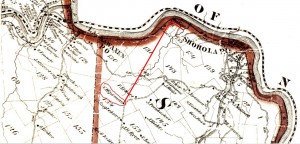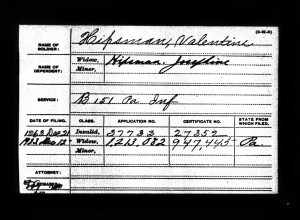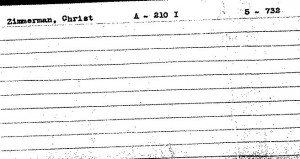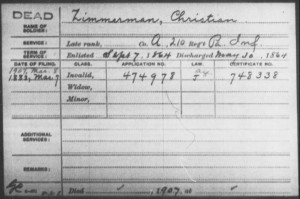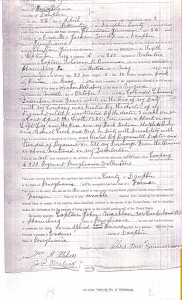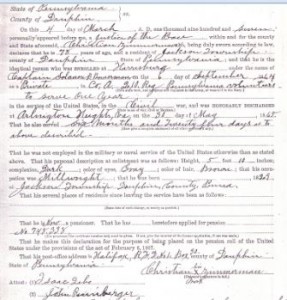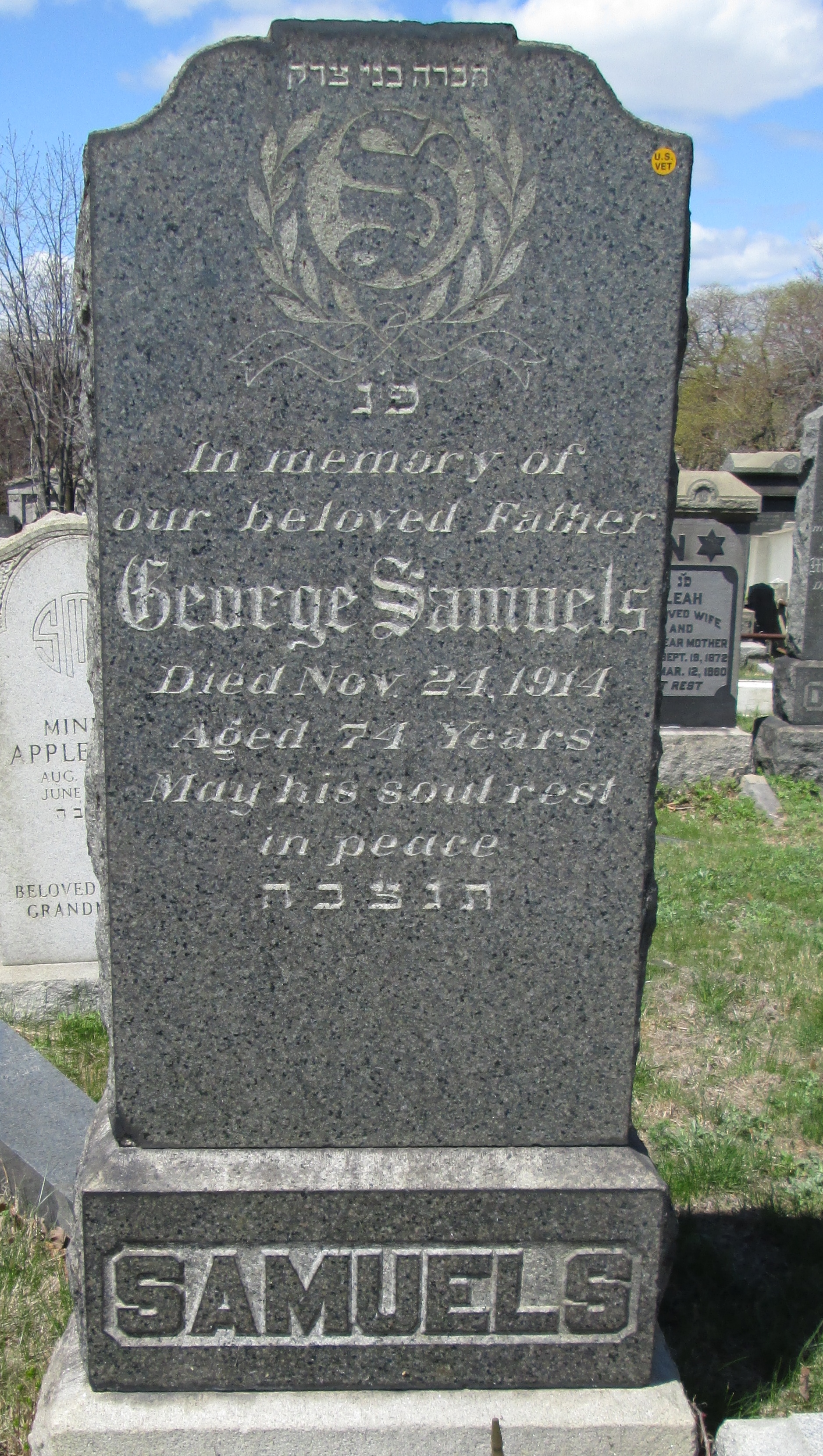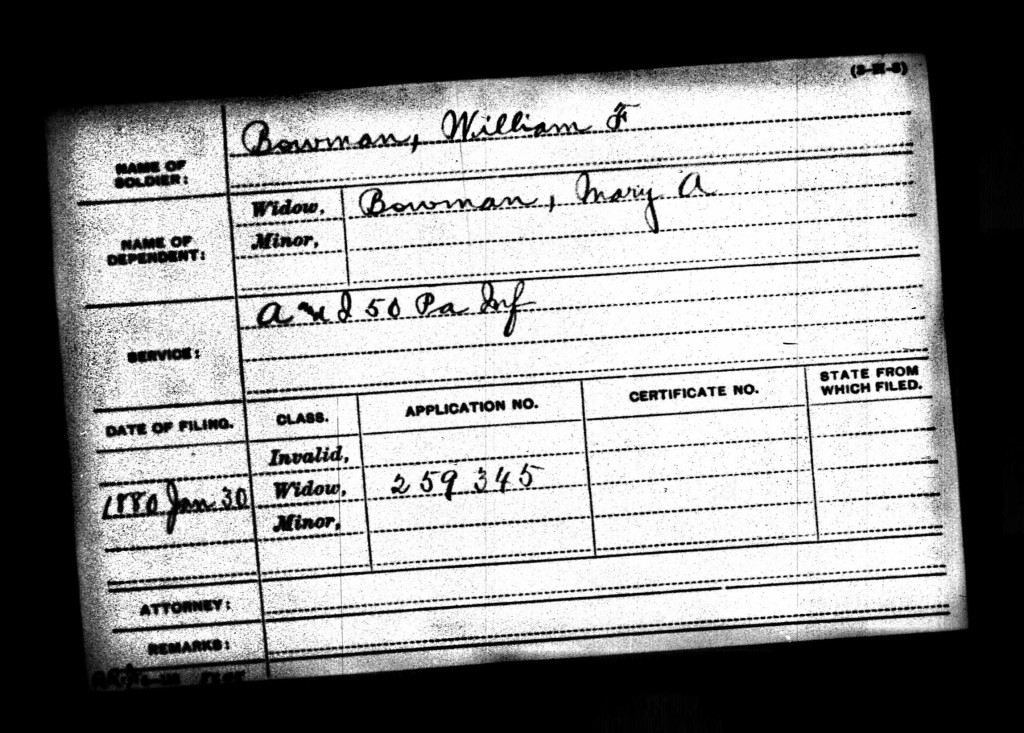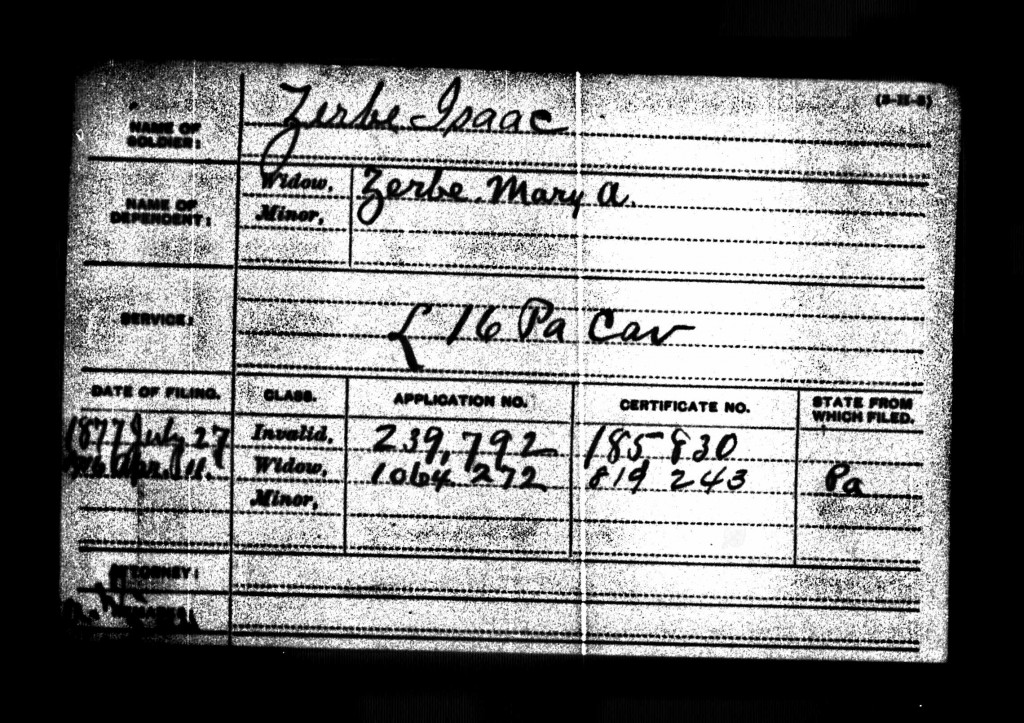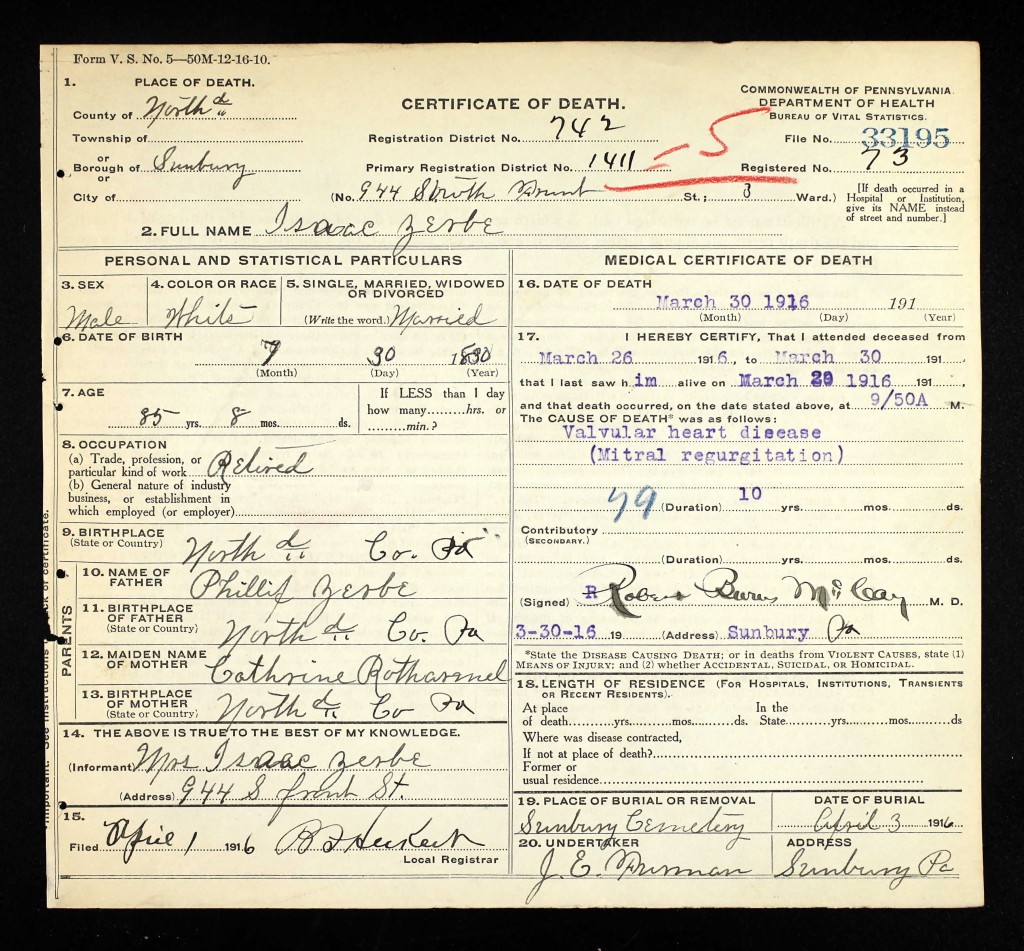Posted By Norman Gasbarro on June 25, 2014
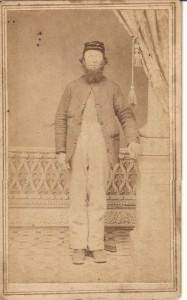
Jacob Shiro was born in Wittenberg, Germany, on 19 February 1843, the son of Jacob Shiro and Susan [Bellon] Shiro. He arrived in the United States around 185 at the age of eight. During the Civil War, he served in Company G, 103rd Pennsylvania Infantry, as a Private, from 14 March 1865 through discharge on 25 June 1865.
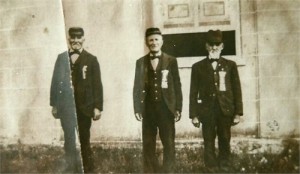
Late in life, Jacob Shiro had his picture taken in his G.A.R. uniform with three surviving Civil War veterans from Gratz. From left, the photo shows Jacob Kissinger, Jacob Shiro, and John W. Hoffman. The photo at the top of this post of Jacob Shiro in his 1865 Civil War uniform was found in the effects of Hannah [Rickert] Riegle, widow of Lykens Township farmer and Civil War veteran Harrison Riegle, a friend and neighbor of Jacob Shiro, who served in the same regiment and company.
In 1955, on the occasion of the Sesquicentennial of Gratz Borough, Dauphin County, a biography appeared in the souvenir book issued for that occasion (page 176-177):
Jacob Shiro… was about one year old when his father died. At the age of six he began to attend school at Wittenberg, and was at school three years. In the spring of 1852, with his mother, step-father and the other members of his family, he emigrated to America. They embarked at LeHavre, France, in a sailing vessel, and after a rough voyage of twenty-nine days, during which they were in the peril of large icebergs, they landed in New York and came directly to Wiconisco where they decided to make their home and where the stepfather, Henry Snyder, at once found employment in the mines. Young Jacob attended the English schools in Wiconisco for four terms and this completed his education.
At the age of thirteen years, he began work in the mines, picking slate at $8 per month, and was employed in the mines for over twenty years.
Mr. Shiro enlisted 10 March 1864 at Harrisburg in Company C, 103rd Pennsylvania Volunteers, under Capt. C. A. Harper. The regiment was ordered to Roanoke Island by way of Fortress Monroe and Norfolk, Virginia, where they were assigned guard duty for six or eight months. They were then ordered to New Bern, North Carolina, to guard the Weldon Railroad. While they were here, a malignant fever broke out among the soldiers, from which as many as a hundred died per day. Mr. Shiro was attacked by the disease, but his sound constitution and his indomitable spirit enabled him to resist the fatal effects of the contagion. He wasn’t going to give up so soon. Although very ill, he continued on duty, and proceeded on the march. He and other comrades hired an old colored man with a cart to carry their knapsacks and equipment, but the rickety vehicle proved inadequate to the strain, and their baggage was dumped on the road. Mr. Shiro determined to push on at all hazards, and resuming his burdens, he continued the march. One of his comrades fell by the wayside and died. Much dispirited and worn in body, they finally reached New Bern, where they rested a short time, and then they pushed on to Morehead City, and boarded the steamer for Baltimore, where they arrived 4 July 1865. They reached Harrisburg 7 July 1865, and on that date were still suffering from the effects of the fever, and he remained in Harrisburg two weeks before he was sufficiently recovered to go home.
During this time his physician at times despaired of his recovery. But he was finally restored to health, and retired to his home. He soon assumed work in the mines, where for four years he held the position of mine foreman.
In 1867, having accumulated $2,000, Mr. Shiro removed with his family to Coles County, Illinois. There he bought one hundred and sixty acres of land, intending to try the life of farming. As there was an unexpired lease on the farm, he could not obtain possession until autumn: he therefore rented the adjoining place for the season. He would have continued to live there but for the loss of his wife, whose death occurred in 1870. This made him homesick, and he returned to his home in Pennsylvania in the fall of that year. He located on a farm in Gratz Borough and in 1872 sold his Illinois farm for $6,000. In 1886, Mr. Shiro opened a general store in Gratz. After the Klinger brothers moved to their new store, Mr. Shiro located in the Odd Fellows Hall. There he successfully conducted a store until he retired from the business, and Abe Gross took over the general merchandise business. Mr. Shiro then operated the North Side Colliery on Short Mountain, known as Shiro’s Mine. Some of the remains can still be seen. Even the rock and dirt bank has been screened for the remaining coal. In the early 20th century the farmers used to visit the place every year before the oats harvest to spend the day in search of the good old mountain huckleberries, to treat themselves in the cold winters to a good huckleberry pie.
Jacob was married three times. In 1862 he married Amanda Moyer. They had two children: Annie Shiro, Mrs. John Schriener, who resided in Illinois; and Carrie Shiro, Mrs. Schild, who resided in Pueblo, Colorado, and later in Gratz. Mrs. Amanda Shiro died in 1870.
In his second marriage in 1872, he was united with Miss Lizzie Deibler, by whom he had one daughter, Lizzie Shiro, wife of Morris Schreffler, Mifflin Township, Dauphin County, later a retired farmer in Berrysburg. Mrs. Lizzie Shiro died in 1875. Mr. Shiro later married Mary Gise, daughter of Benjamin Gise, of Gratz. They had one child, Jacob B. Shiro.
Jacob was a strong Democrat. He served as postmaster of Gratz for several years, having been first appointed under President Garfield. The Gratz mail in that day was not large, and so was laid out on the counter. Later, as the mail increased, the mail box came into use. He was a member of Lodge No. 563m I.O.O.F. at Gratz, and the G.A.R. Encampment at Gratz; also of Lykens Valley Lodge, No. 365, K. of P. at Gratz. He was a member of the Evangelical Church.
While there are some similar statements and information, the text of the biographical sketch of Jacob Shiro that was printed in the Commemorative Biographical Encyclopedia of Dauphin County, page 893, is presented here:
Jacob Shiro, merchant, Gratz, Pennsylvania, was born in Wittenberg, Germany, 19 February 1843. He is a son of Jacob Shiro and Susanna [Bellem)] Shiro. Jacob Shiro Sr., was born in France, and was a soldier in the French army, with which he crossed into Germany during one of the wars of religions. At the close of the war he married and settled in Wittenberg, where he conducted a public tavern until his death which occurred about 1844. His children are: Mina Shiro, Mrs. James Bocker of Harrisburg, and Jacob Shiro Jr. His widow married Henry Snyder; she died in 1893. Mr. Snyder survives her and resides in Lykens Township, Dauphin County, Pennsylvania where his wife died. The children of her second marriage are: Angeline Shiro, Mrs. Daniel Reichert, Williamstown, Pennsylvania; Rose Shiro, first married Adam Frederick, deceased, and is now Mrs. Samuel Boke; Henry Shiro, farmer, Gratz, Pennsylvania; Amanda Shiro, Mrs. John Coleman, Gratz, Pennsylvania, and John Shiro, farmer, Lykens Township.
Jacob Shiro Jr., was about one year old when his father died. At the age of six he began to attend school in Wittenberg, and was at school three years. In the spring of 1852, with his mother, stepfather and the other members of his family, he emigrated to America. They embarked at Havre, France, in a sailing vessel, and after a rough voyage of twenty-nine days, during which they were in constant peril from the neighborhood of large icebergs, they landed in New York and came directly to Wiconisco, where they decided to make their home and where the stepfather at once found employment in the mines. Young Jacob attended the English schools in Wiconisco for four terms, and this completed his school education. At the age of thirteen years he began work in the mines, picking slate at $8 per month, and has been employed in the mines for over twenty years.
Mr. Shiro enlisted 10 March 1864, at Harrisburg, in Company G, One Hundred and Third Pennsylvania Volunteers [103rd Pennsylvania Infantry], under Capt. C.A. Harper. The regiment was ordered to Roanoke Island by way of Fortress Monroe and Norfolk, where they were assigned to guard duty for six or eight months. They were then ordered to New Bern, N.C., to guard the Weldon railroad. While they were here a malignant fever broke out among the soldiers, from which as many as a hundred died per day. Mr. Shiro was attacked by the disease, but his sound constitution and his indomitable spirit enabled him to resist the fatal effects of the contagion. Although very ill he continued on duty, and proceeded on the march. He and other comrades hired an old colored man with a cart to carry their knapsacks and equipment, but the rickety vehicle proved inadequate to the strain, and their baggage was dumped on the road. Mr. Shiro determined to push on at all hazards, and resuming his burden, he continued the weary march, on which one of his comrades fell by the wayside and died. Much dispirited and worn in body, they finally reached New Bern, where they rested a short time, and then pushed on to Morehead City and boarded the steamer for Baltimore, where they arrived 4 July 1865. They reached Harrisburg 7 July 1865 and on that date were honorably discharged from the service. Mr. Shiro was still suffering from the effects of the fever, and remained in Harrisburg two weeks before he was sufficiently recovered to go home. During this time his physician at times despaired of his recovery. But he was finally restored to health, and retired to his home. He soon resumed work in the mines, where for four years he held the position of mine foreman.
In 1877, having accumulated $2,000, Mr. Shiro removed with his family to Freeport, Illinois, and from that place to Coles County, Illinois. There he bought one hundred and sixty acres of land, intending to try the life of a farmer. As there was an unexpired lease on the farm he could not obtain possession until autumn; he therefore rented the adjoining place for the season. Mr. Shiro remained three years in Coles County, and was successful as a farmer. He would have continued to live there but for the loss of his wife, whose death occurred in 1880. This decided him to return to his old home in Pennsylvania, which he did in the fall of that year. He located on a farm in Gratz, and in 1882 sold his Illinois farm for $6,000. In 1886 Mr. Shiro opened a general store in Gratz, Pennsylvania which he has successfully conducted since that time. He also operates the North Side colliery on Short Mountain.
Mr. Shiro has been married three times. In 1862 he married Amanda Moyer. They had two children: Annie Shiro, Mrs. John Schreiner, residing in Illinois, and Carrie Shiro, Mrs. Shield, residing in Pueblo, Colorado. Mrs. Amanda Shiro died in 1880. In his second marriage, in 1882, Mr. Shiro was united to Miss Lizzie Diebler, by whom he had one daughter, Lizzie Shiro, wife of Morris Schreffler, Mifflin Township, Dauphin County, Pennsylvania. Mrs. Lizzie Shiro died in 1885. Mr. Shiro is now married to Mary Gise, daughter of Benjamin Gise. They have one child, Jacob B. Shiro. Mr. Shiro is a strong Democrat. He served as postmaster of Gratz for several years, having been first appointed under President Garfield. He is a member of Lodge No. 563, I.O.O.F., at Gratz, and of the Encampment at Gratz; also of Lykens Valley Lodge, No. 365, K. of P., at Gratz. He is a member of the Evangelical church.
Finally, a biographical sketch of Jacob Shiro appeared in A Comprehensive History of the Town of Gratz Pennsylvania, pages 33-35, which was published in 1997:
On 14 May 1870, Jacob Tallman sold his farm to Jacob Shiro who was also an immigrant from Germany and a distant relative.
Jacob Shiro was born 19 February 1843, in Wurttemberg, a son of Jacob Shiro Sr. and his wife Susanna [Bellon] Shiro. The father, Jacob Shiro Sr., was born in France, and was a soldier in the French Army. While in the army, he crossed into Germany during one of the religious wars. At the close of the war, he settled in Wurttemberg where he operated a public tavern until his death in 1844. He left a wife and two young children: Mina Shiro, who in later years married James Bocker and lived in Harrishurg; and Jacob Shiro, who later lived in Gratz.
After here husband died, Susanna [Bellon] Shiro was married to Henry Snyder. They remained in Wurttemberg for several years, but in the spring of 1852 the family emigrated to America. They embarked from LeHavre, France, and after a voyage of twenty-nine days they landed in the port of New York City. From there, they came directly to Wiconisco, perhaps living in that area for a few years. Henry Snyder became employed in the mines. When he was thirteen years old, Jacob Shiro also beame employed at the mines. Jacob picked slate and was pain eight dollars per month.
Henry Snyder and Susanna Snyder lived in Lykens Township. They had a small log house and bank barn surrounded by a few acres of ground. It was located quite a distance off the westerly end of Indian Trail Road near the base of the mountain. When Jacob Shiro opened his mine on the Gratz side of Short Mountain, Henry Snyder worked for him for at least a brief time.
After Susanna Snyder died of blood poisoning, Henry went to live with their son John. He remained in good health and helped with the chores on his son’t farm. The day of his death, Henry ate a hearty dinner and then went to the barn to do some work. It was there that he died suddenly, and was found a short time later….
Jacob Shiro was a veteran of the Civil War. When he came home from the war he married Amanda Moyer. Several years later, about 1867, Jacob and Amanda, accompanied by her parents Christian Moyer and Elizabeth Caroline Moyer, moved to Illinois. Several other families went “west” about that time. In 1868, Jacob purchased a farm of one hundred-sixty acres and the family planned to settle there….
In 1869 Amanda died in childbirth. Jacob became so disheartened that he sold the farm immediately and came back to Gratz. He left the two young daughters with their Moyer grandparents, where they remaine for most of their young life.
After he came back to Pennsylvania, Jacob lived in Lykens Township with his mother and stepfather and found employment as a miner, but soon purchased the fifty-six acre farm in Lykens Township from Jacob Tallman. He accumulated more tracts of land until he had a total of about 106 acres. The land runs from the Indian Trail Road to the road leading from Gratz to Loyalton, minus a few acres sold off for lots.
The setting of the farm is serene and beautiful. Its location with easy access to the creek lens itself well to water power. As early as 1834, a saw mill had been located on the land. Saw milling continues on the property for many years, through several ownerships. It became known as the “saw mill place.” Harry Shiro Sr. described the saw mill owned by Jacob his grandfather, as the “up and down” type with one-fourth inch blades. In 1897 Jacob Shiro purchased a shingle mill.
Jacob Shiro built the first grist mill on the property about 1870, east of the present day woods. Today the site is barely traceable. A devasting flood in 1913/1914 completely destroyed the mills, and the breast of the dam. Since then, other severe floods have slightly changed the position and location of the dam.
The house itself dates to a very early period, probably about 1832. The south wall of the house contains early original logs. Jacob Shiro constructed the south wing of the house from boards used in the sawmill. Other additions were added over the years.
On 22 October 1877, Jacob Shiro and Frederick Coleman signed a contract to lay about 300 feet of wooden pipes from the mountain spring through the land of Coleman to the Shiro property. This continuous flow of water from the mountain has been the source of supply for the barn and house, as well as the dam for the past 120 years – not a small fete.
Jacob Shiro had many other enterprises in addition to farming. In 1886 he opened a general store in Gratz. During the years of 1896 and 1897 he was busy hauling wooden poles to various customers. In May 1896 he delivered a seventy-foot pole to the Lykens Brewery. That same year he had a contract with Standard Oil to deliver poles for installation along their new oil line east of Gratz. He also contracted with Lykens Valley Telephone and Telegraph Company to supply 250 poles when it began operation in this area in 1897. In 1886, Jacob Shiro became superintendent of a coal operation on the Gratz side of Short Mountain….
In later years, Jacob Shiro and his wife moved to a house on Market Street in Gratz. They lived in that place for the remainder of their lives.
The property belonged to the Shiro family for 115 years. Jacob Shiro Sr. sold it to his son Jacob B. Shiro. He in turn sold it to his son Harry Shiro. After Harry Shiro died, the farm was sold at public auction in November 1987 to Robert Rodichok. The house has very recently taken on a different look.
Jacob Shiro died on 25 October 1920 at Gratz. The cause of death was given as valvular heart disease. The informant for the death certificate was his son Jacob.
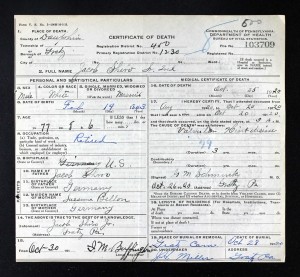
Click on document to enlarge.
Pennsylvania Death Certificates are available on Ancestry.com for the period 1906-1926.
Category: Research, Resources, Stories |
Comments Off on Jacob Shiro – Farmer, Merchant & Postmaster of Gratz
Tags: Berrysburg, G.A.R., Gratz Borough, Loyalton, Lykens Borough, Lykens Township, Mifflin Township, Wiconisco, Williamstown
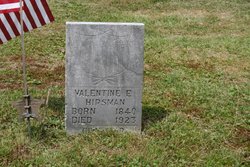
 ;
;
